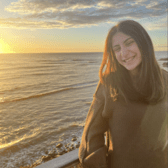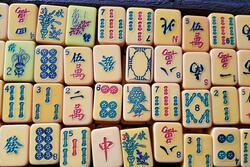Praying for a Feminist Future at the Kotel
When I was younger, the Kotel didn’t spark a lot of meaning to me. My family visits had the same routine; I would pull on a skirt over my shorts and split up from my dad and brothers to go to the women's section. While I stood silently facing the wall, my mom often got very emotional for reasons I did not understand. I knew that the site was religiously significant to Jews, but I did not yet have my own Jewish identity that made the Kotel feel meaningful.
However, as I have grown my personal religious and spiritual identity in recent years, my relationship to the Kotel has become more meaningful and complex. High school served as one of my first opportunities to create a Jewish identity separate from my family. I discovered the aspects of Judaism that spoke to me, especially regarding prayer. I began frequently leading my egalitarian minyan at school and finding ways to observe tradition as a Jewish leader.
As my spirituality developed, the Kotel became a truly holy site for me. When I rest my head on the warm and textured stones, I feel God listening more than I do anywhere else. I stand in the place that my Jewish ancestors celebrated the same holidays and worshipped the same God.
But when I am standing on the women’s side, the perfect facade of the Kotel begins to fade away. I wonder why the women are silent while I hear communal chanting and rejoicing coming from the men’s side. I feel my Jewish and feminist identity coming into conflict. Why does the place that validates my connection with God also feel like it is silencing my and other women's voices?
I frequently refer back to this story of someone I know who returned to their midrasha in Jerusalem after visiting the concentration camps. As a sign of resilience and strength, she and her (all-female) group began singing and dancing at the Kotel early morning, celebrating Jewish survival. But their celebrations were promptly interrupted—they were women and therefore could not be creating this much noise or drawing this much attention, despite the very few visitors at the Kotel.
Stories like these detract from the value of the Kotel and make it inaccessible for people who do not want to adhere to certain strict religious rules.
This past summer, I heard from a representative for Women of the Wall (WOW), an organization that strives to give women at the Kotel the opportunity to wear tallitot, read from the Torah, and pray loudly as a group at a holy site.
The organization grew as a response to an incident in 1988 when a group of Jerusalemite women attempted to read aloud from a Torah scroll on Rosh Chodesh but instead encountered a violent riot of men who were outraged at the sight of women holding a Torah. The men spat and cursed at the women, and forcefully grabbed the Torah from their hands.
After the continuous resistance from members of WOW despite being arrested multiple times, the Supreme Court vowed to turn the nearby Robinson’s Arch into a “well-ordered prayer site” in 2003, where non-orthodox services could occur, and to maintain the Kotel itself as Orthodox. While this site now serves as a place where people can hold egalitarian services, it is not nearly as developed, central, or publicized as the Western Wall, and therefore less accessible to egalitarian Jews.
Because I find communal prayer extremely powerful and unifying, the mission of WOW deeply resonates with me. I don't want to just say my own silent prayer; I want to sing Jewish songs and learn new tunes and dance in circles with strangers who also want to embrace their Jewish identity in a historic and holy site.
Learning about the mission of Women of the Wall made me realize that my discomfort at the Kotel wasn’t just a personal dilemma—it was part of a larger, ongoing struggle for religious equity. It wasn’t just me feeling silenced or just my voice that longed to rise in song. There is a community of women who have been fighting for decades to make space for all expressions of Jewish prayer at this sacred site. Their courage made me feel less alone and more hopeful for an inclusive future.
At the same time, I deeply value Jewish tradition. I understand why certain practices are preserved with such care, and I don’t take lightly the responsibility of honoring what came before me. My connection to Judaism is built on both reverence and questioning. This tension—between preserving tradition and pushing for change—is not one I’ve fully resolved. But it’s one I’ve learned to embrace.
I believe the Kotel should be a place where complexity is welcome, where prayer is expansive, and where every Jew, regardless of gender or denomination, can feel seen and heard. Just as I’ve found meaning in leading prayer within my school community, I hope to help shape a Jewish future where that kind of inclusive and spirited connection is possible—even at our most sacred sites.
This piece was written as part of JWA’s Rising Voices Fellowship.







